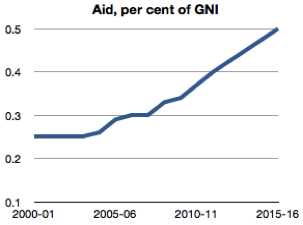There a strong case for aid and bipartisan support in Australia for an aid target of 0.5 per cent of GNI by 2015-16. This implies a doubling of aid from about $4 billion in 2010-11 to $8 billion in 2015-16.
The current Labor government has already taken important steps to improve aid effectiveness: it reaffirmed a commitment to use aid for poverty reduction; it introduced the Pacific Partnerships for Development and a stronger focus on results; and it has published annual reviews of development effectiveness.
Nevertheless there has also been criticism of aspects of aid program, notably the extensive use of expensive advisers and the review of the Australia-PNG aid treaty.
The Coalition have said that if they form the next government they will appoint a Minister for International Development to review aid effectiveness and to oversee a scaling up of aid.
This would be an important step forward, but there are also broader issues that need to be addressed – notably the uncertainty about how Australia will scale up aid to $8 billion.
The 2006 White Paper on Australian aid was a useful framework for the last doubling of aid: from $2 billion in 2004-05 to $4 billion this year, but it has not been updated or replaced.
The current Labor government did make an aid policy statement in the 2009-10 budget and this included the following core principles:
- accelerating progress towards the Millennium Development Goals;
- a recognition that while economic growth is the most powerful long-term solution to poverty, economic growth will not, by itself, deliver fair and stable societies;
- a strong emphasis on the Asia-Pacific, while also increasing our efforts in Africa and South Asia;
- an emphasis on the power of education to promote development; and
- a commitment to continue to improve effectiveness.
These principles make strategic sense – especially the strong focus on poverty reduction. But it doesn’t add up to a concrete plan for scaling up aid. Important questions need to be answered:
- How and where will aid be allocated? What will be the balance between bilateral and multilateral aid?
- How will AusAID make bilateral (and multilateral) aid more effective and what kind of aid instruments will the aid program deploy?
- How will we know what programs aid is spent on, which programs work and what results have been delivered?
- How will aid be coordinated with and complemented by broader development policies (such as trade, migration and finance)?
Whichever party forms government they will need to address these issues. And given the importance of building and maintaining public support for the aid program, this should be done through public consultation and debate.
The the run up to the UN Summit on the Millennium Development Goals later this month would be a perfect opportunity to commission a white paper that sets out how Australia will double the aid program and improve the impact on poverty. And this would reaffirm a new government’s commitment to global poverty reduction.
Matthew Morris is the Deputy Director of the Development Policy Centre and a Research Fellow at the Crawford School of Economics and Government.


Matt,
Good post, and yes, we definitely need a plan for Australian aid. Have you seen the online discussion that Oaktree eXchange had? It raised some interesting questions about the balance of funding between private contractors and NGOs. It also highlighted the fragmentation of international development efforts – something that our government needs to keep in mind when thinking about going into Africa and Latin America.
http://theoaktree.org/blog/2010/08/17/oaktree-exchange-aid-effectiveness/
Best wishes,
Nick